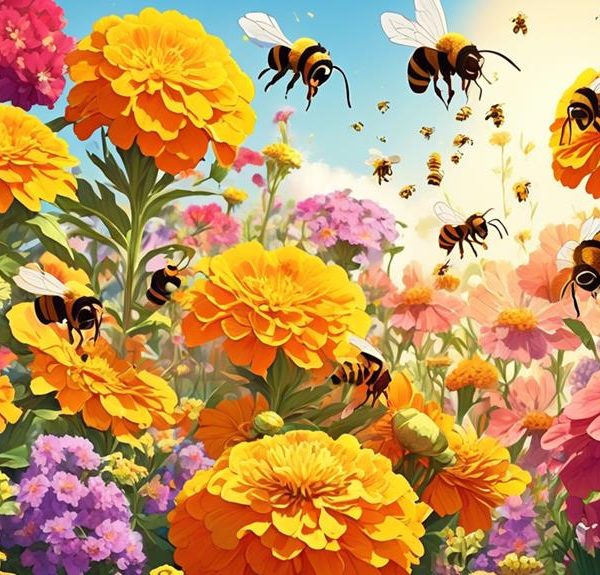Solve the mystery of whether bees are truly attracted to apple trees and discover the intricate dance of nature's relationship.

Do Bees Like Apple Trees
Imagine you're a bee, buzzing through an orchard on a warm spring day. You spot an apple tree in full bloom, its pink and white blossoms dotting the branches like a Monet painting.
Now, the question isn't whether this scene is picturesque, because it undeniably is. The real question you might be asking is, do bees, like you in this scenario, gravitate towards apple trees?
Well, it's a bit more complicated than a simple yes or no answer. Stay with us as we unpack the intricacies of this relationship, exploring the allure apple blossoms hold for bees, and the reciprocal benefits this interaction provides.
Key Takeaways
- Bees are attracted to the bright colors and sweet nectar of apple blossoms.
- Bees play a crucial role in apple tree pollination, facilitating fruit production.
- Bees' unintentional cross-pollination significantly boosts fruit production in apple trees.
- The symbiotic relationship between apple trees and bees is essential for their survival and biodiversity.
Understanding Bees' Pollination Behavior

To truly grasp the role of bees in apple tree pollination, you need to understand their unique pollination behavior, which is a fascinating mix of instinct, efficiency, and precision.
Bees have evolved a finely tuned system for collecting and distributing pollen. They're attracted to the bright colors and sweet nectar of apple blossoms, and as they move from flower to flower, pollen grains stick to their fuzzy bodies.
The pollen doesn't stay on the bee for long though. As the bee visits another flower, it brushes against the sticky stigma of the flower, depositing pollen. This transfer of pollen from the male anther of a flower to the female stigma is what we call pollination, and it's essential for fruit formation.
What's remarkable is the bees' fidelity to a single type of flower during a foraging trip. Known as 'flower constancy,' this behavior ensures that pollen is transferred between flowers of the same species, which is crucial for effective pollination.
In short, bees aren't just accidental pollinators. They're nature's precision-guided pollinators, and understanding their behavior can help us enhance the productivity of apple orchards.
Apple Trees and Their Blooming Period
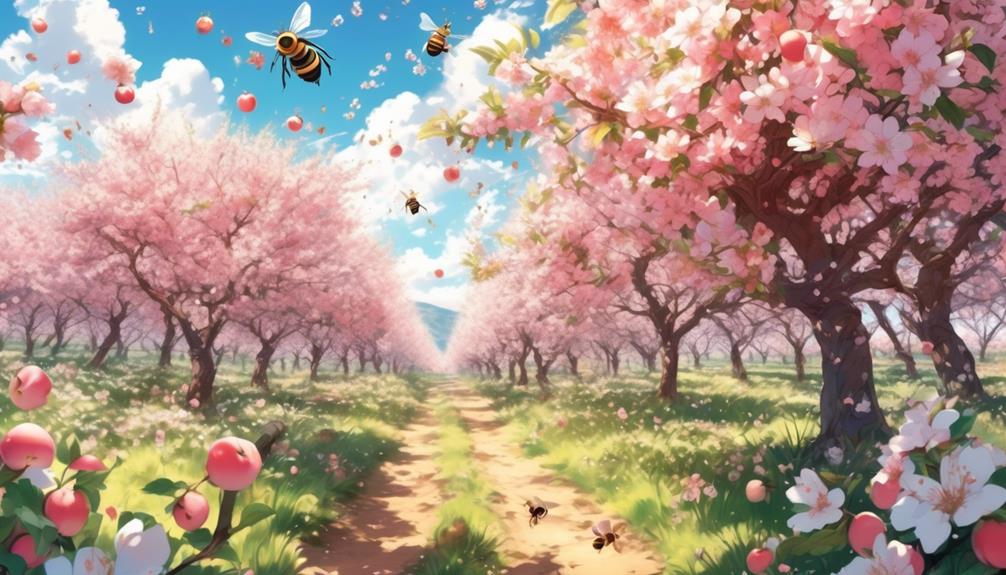
You'll find that apple trees have a specific blooming period, typically in the spring, when they explode in a stunning display of fragrant blossoms, creating an ideal environment for bees to work their pollination magic. This time of year is crucial in the lifecycle of both the apple tree and the bee population.
During this blooming period, apple trees become a hub of activity. The sugary nectar of the blossoms attracts bees, which in turn carry pollen from male to female tree parts, facilitating fertilization. This symbiotic relationship is integral to the propagation of apple trees and the survival of bees.
This table captures the essence of this period:
Stage | Description |
|---|---|
Budding | The tree begins to show signs of life after winter dormancy |
Blooming | The tree is adorned with beautiful, fragrant blossoms |
Pollination | Bees busily collect nectar, inadvertently pollinating the trees |
Fruit set | Successful pollination leads to the formation of apples |
Observing this process, you'll appreciate the intricate balance of nature. The blooming period of apple trees, while brief, plays a significant role in the survival and prosperity of both the trees and the bees that pollinate them.
The Role of Apple Flowers in Attracting Bees
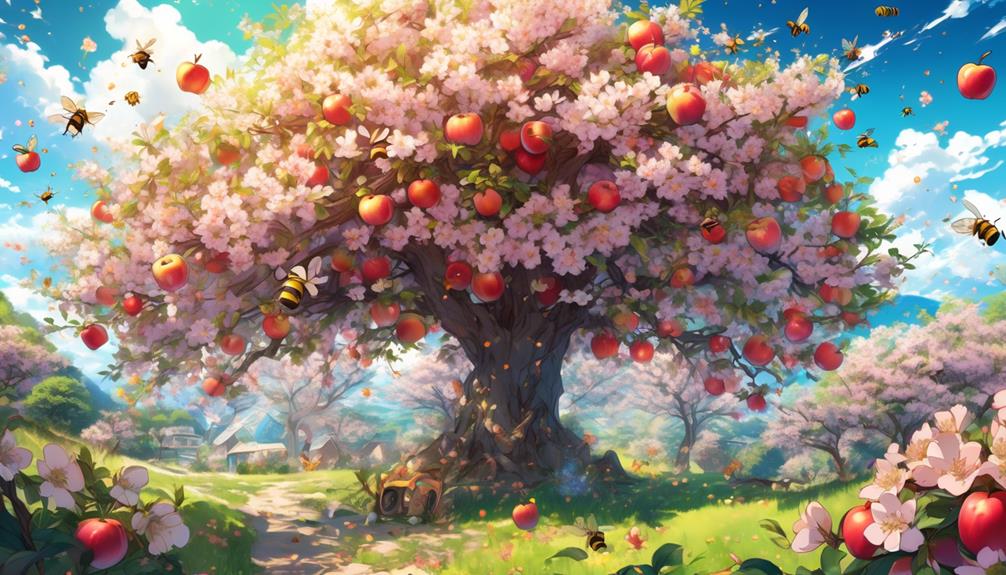
Building on the importance of the blooming period, let's examine how apple flowers, with their sweet nectar and vibrant blossoms, play a pivotal role in attracting bees.
You see, apple flowers contain a unique blend of nectar and pollen, two nutrients that are crucial for bees' survival. The nectar, a sweet liquid produced by the flowers, provides bees with their primary source of energy. Meanwhile, pollen, which is rich in proteins and fats, helps in the growth and development of bee larvae. Bees are naturally attracted to these sources, which is why you'll often see them buzzing around apple blossoms.
However, it's not solely about the food. The vibrant colors of apple blossoms serve as visual lures for bees. Bees can see ultraviolet light, which humans can't. This ability allows them to detect patterns on the flowers that guide them to the nectar and pollen.
Furthermore, the strong, sweet scent of apple flowers is another powerful attractant for bees. They can pick up this fragrance from a distance, drawing them towards the apple trees.
Nutritional Benefits Bees Get From Apple Trees
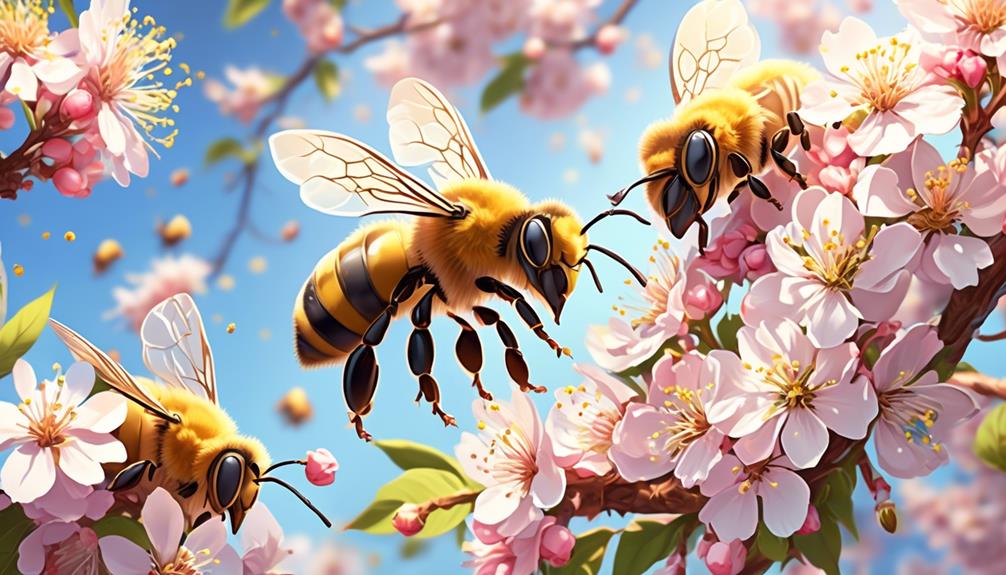
Delving into the heart of the matter, it's fascinating to observe how bees derive significant nutritional benefits from apple trees.
As a bee, the main factor that draws you to these trees is the rich, sugary nectar found in apple blossoms. This nectar is your primary source of energy, providing essential carbohydrates.
But that's not all. Pollen, another product you collect from apple trees, is a bee's main protein source. It's packed with proteins, vitamins, lipids and minerals, vital for your growth and development. You use it to feed your larvae and to produce royal jelly, a substance crucial for the development of new queen bees.
The synergy between you and apple trees goes even deeper. Apple trees bloom in spring, when you're emerging from hibernation and need food sources. The trees' blossoms are abundant and accessible, making them ideal for you.
Impact of Bees on Apple Tree Fertilization
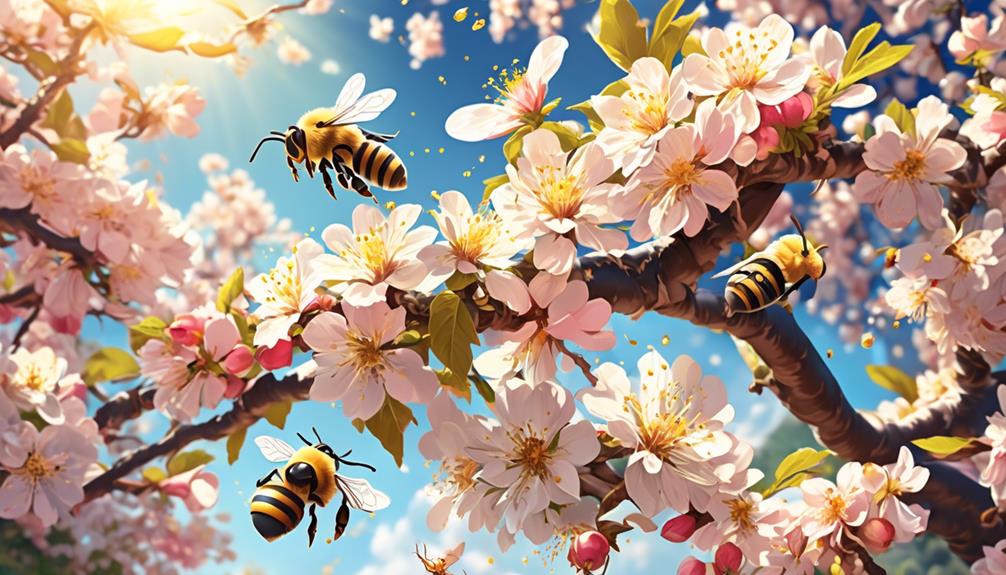
On the flip side, it's your pollination activities as bees that play a pivotal role in apple tree fertilization, significantly boosting their fruit production. As you go about your typical day, collecting nectar and pollen, you unintentionally transfer pollen from the male parts of a flower to the female parts. This process, known as cross-pollination, is essential for fruit set in apple trees.
To illustrate this, consider the table below:
Pollinated by Bees | Not Pollinated by Bees | |
|---|---|---|
Number of Apple Trees | 1000 | 1000 |
Average Fruit Set per Tree | 150 | 50 |
Total Fruit Production | 150,000 | 50,000 |
As you can see, the impact of your pollination on apple tree fertilization is significant. Without you, fruit production can drop by up to two-thirds! Your role in nature's cycle is therefore vital, helping to sustain apple tree populations and contribute to biodiversity.
Strategies to Attract Bees to Your Apple Trees

To maximize your apple trees' fruit production, you'll need to employ effective strategies to attract more bees to your orchard.
Bees are drawn to an abundance of diverse flowering plants, so consider growing a variety of native plants that bloom at different times throughout the growing season. This provides bees with a continuous source of nectar, encouraging them to stay in your orchard longer.
Another strategy is to limit the use of pesticides. These chemicals can harm bees and deter them from visiting your trees. Instead, opt for organic pest control methods and apply them during the evening when bees are less active.
You could also install bee houses or hives in your orchard. Not only will this provide a safe habitat for bees, but it'll also ensure a steady population of these pollinators in close proximity to your apple trees.
Frequently Asked Questions
What Other Types of Fruit Trees Do Bees Commonly Pollinate?
You're curious about what other fruit trees bees commonly pollinate. Bees aren't picky; they love all types of fruit trees! Cherries, peaches, plums, and citrus trees often see these buzzy pollinators.
Pear trees also attract them. However, bees' favorites are often berry bushes, like blackberries and raspberries. They're key in helping these fruits grow.
Are There Specific Breeds of Bees That Are More Attracted to Apple Trees?
Yes, there are specific breeds of bees that show a preference for apple trees. Honeybees are particularly fond of apple blossoms due to their high nectar content.
Mason bees, another type, are excellent pollinators of apple trees, even more effective than honeybees. It's due to their hairy bodies that hold pollen well and their tendency to visit many flowers, spreading pollen effectively.
Different bee species indeed have different flower preferences.
How Does Weather or Climate Affect a Bee's Attraction to Apple Trees?
Yes, weather plays a significant role in a bee's attraction to apple trees. Bees prefer warm, sunny conditions for foraging.
During cold or rainy weather, you'll notice less bee activity as they tend to stay in their hives.
Prolonged periods of bad weather can even impact a bee's ability to recognize and remember the scent of apple blossoms.
What Are the Potential Threats to Bees When They Pollinate Apple Trees?
There are several threats you'd want to consider when bees are pollinating apple trees.
Pesticides, often used on apple trees, can be toxic to bees.
Parasites and diseases can also be a concern, especially Varroa mites and Nosema fungus.
Weather conditions can also pose a risk; heavy rain, wind or cold temperatures can harm bees.
Lastly, habitat loss due to human activities can threaten bees' survival.
Can Bees Help in Improving the Quality of the Apples Produced?
Yes, bees can indeed help improve the quality of your apple crops.
When bees visit your apple trees, they transfer pollen from the male parts of a flower to the female parts. This process, known as pollination, is crucial for fruit production.
The more thoroughly a flower is pollinated, the more seeds it'll produce. More seeds often mean larger, healthier apples.
Conclusion
So, do bees like apple trees? Absolutely!
Apple blossoms are a bee magnet, providing essential nutrients they crave.
Not only do bees gain nourishment, but they're also crucial for apple tree fertilization.
To maximize this symbiotic relationship, there are strategies you can use to make your apple trees more attractive to bees.
Understanding the dynamics of this relationship can help you improve your apple yield and contribute to bee conservation efforts.

